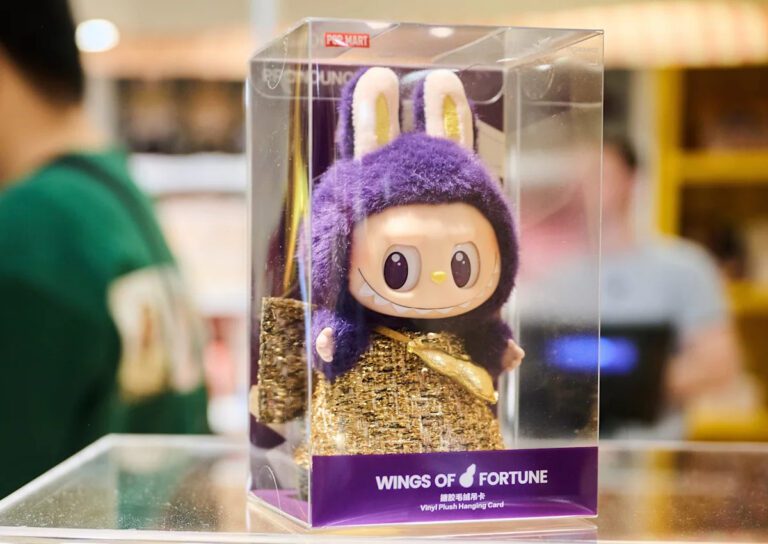Hundreds of thousands of fake Labubu dolls have been seized at the UK border this year, new figures show.
In a demonstration of the popularity of the dolls, 90% of the 259,000 fake toys seized this year were counterfeit Labubu dolls – about 236,000 items.
The furry monster-like dolls were made popular by Chinese toy manufacturer Pop Mart and have been promoted by celebrities worldwide. Counterfeit versions of the creatures – dubbed ‘Lafufus’ – often have the incorrect number of fangs, along with misshapen heads and/or twisted limbs.
The dolls, set to be a best-selling toy this Christmas, are being sold for around £20, while the authentic dolls can be sold for hundreds of pounds.
Due to their popularity, the demand for fake dolls is huge. Last week hundreds of counterfeits were seized in London and Derby alone, while another 100 were seized in Moray at the start of September and a collection of dolls worth £2,000 were seized in Walsall last month.
Kensington and Chelsea Council said the raids were carried out across seven local shops, with the “poorly made” fakes posing “a choking hazard due to their small parts such as eyes and feet which could easily come off from the soft toy”.
One of the counterfeit Labubu dolls seized at the UK border. (PA/IPO)
The dolls may be cheaper than their genuine counterparts but they come with health and safety issues – expert testing of seized fake goods had found banned chemicals linked to cancer and dangerous choking hazards.
Intellectual Property Office deputy director of enforcement Helen Barnham said: “Behind the packaging can be hidden choking hazards, toxic chemicals and faulty parts that put children in real danger.
“These products have bypassed every safety check the law requires, which is why we’re working with our partners to keep these dangerous fakes out of UK homes.”
Kerry Nicol, external affairs manager at the Chartered Trading Standards Institute (CTSI), added: “Dangerous counterfeits are finding their way into the market, often being sold by third-party sellers on online marketplaces and from shops on the high street that have no regard for the safety of their customers.”
How to spot a fake Labubu doll
The fake dolls, which are often sold by third-party sellers and shops, are poorly made and unsafe for children, with detachable parts and loose stitching – both of which could become a choking hazard.
They could also contain toxic substances such as lead, banned plasticisers or harmful dyes.
If you have bought a product from TikTok or other online platforms, the warning signs that it might be a fake are often in the packaging or the label.
Fake products can sometimes ship in genuine packaging, as this can be bought cheaply online. Lawson warns: “Sometimes counterfeiters recycle genuine product packaging (cosmetics likely to be targeted the most with this trick) so consumers should look out for tampered packaging, seals, wrapping etc.”
The fake Labubu toys often have the incorrect number of fangs. (PA/IPO)
It also pays to check the label, Lawson advised. Genuine Pop Mart Labubu dolls have a very distinctive elf-like design, a holographic Pop Mart sticker, a scannable QR code linking to the official Pop Mart website and, on some newer editions, a scannable UV stamp on one foot – features that are difficult to fake.
There are also notable quality differences between real and fake Labubus. Real dolls have nine fang-like teeth, a mischievous expression, a well-applied blush on their cheeks and high-quality fur, while counterfeit ones can have a different shaped smile and mouth, odd or muted colours, uneven fur and even a misshapen head or limbs.
Why are fakes such a problem on online marketplaces?
It’s not just physical stores where there is a problem. Social media platforms such as TikTok pose an additional problem in regards to buying counterfeit goods because of the simplicity of buying and because some influencers can make consumers feel pressured to buy.
An investigation by Which? also found large amounts of fake products on marketplace platforms like eBay and Vinted.
Counterfeiters are taking advantage of consumers being more easily swayed by influencers on platforms like TikTok. (AP)
“The rapid growth of marketplaces such as Tiktok means that shopping is made easy with a simple click of a button, and in a world of adverts and sponsorship, there is greater pressure on the consumer to buy products endorsed by their favourite influencer or brand ambassador, and counterfeiters are taking advantage of that convenience,” intellectual property lawyer Fiona Lawson at Freeths law firm tells Yahoo News.
“Counterfeit goods not only pose a significant threat to the reputation of a brand but also present serious health and safety to the consumer, as well as environmental risks.”
Fake toys worth more than £3.5 million have been seized at the UK border already this year. (PA/IPO)
Lawson says that counterfeit electrical goods can be dangerous, with up to 98% not meeting safety standards, according to the Intellectual Property Office.
In some cases, this means they can cause fires or electrical shocks – and faked perfumes can contain harmful chemicals, Which? reported.
Basic checks before you buy
The warning signs of fake goods online marketplace platforms are often in the accounts of influencers offering them, and how products are sold, Lawson explains. Adverts offering too-good-to-be-true prices are often a sign of counterfeits.
Lawson said: “To shop safely on TikTok and steer clear of counterfeits, consumers should check if the account is verified and be wary of ads offering heavily discounted products or flash sales, as these can often be linked to fake websites.
Consumers should check to make sure they are buying genuine Labubu dolls. (PA)
“Similarly, an increase in the frequency of specific product ads/placements over short periods of time can be indicators of counterfeit activity.
“Consumers should always be extra wary of requests to transfer money before making a purchase.”


